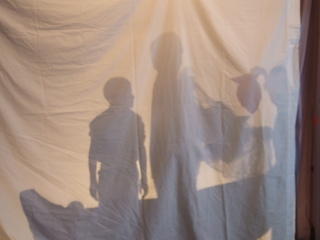The first resource post in this topic is a Drama Workshop "manual" from Amy Crane, one of our most prolific drama and puppet lesson and idea contributors here at Rotation.org. The third post in the thread is an older Drama Workshop manual that shares some different ideas and and additional tips.
In the past few years, our Writing Team has expanded what's creatively possible in a "Drama" Workshop. They've brought in music, movement, taking photos, shadow theater, blacklight, and many "scriptless" techniques. You'll see some of the Team's techniques discussed in this public forum! Go to our Writing Team Lesson Sets to see their Drama Workshop lesson plans (Supporting Member access required).
What is the "Drama Workshop" ?
In the Workshop Rotation Model for Sunday School, the "Drama Workshop" is a Bible lesson that primarily uses playful drama techniques as its main activity to both teach the story and explore its meaning.
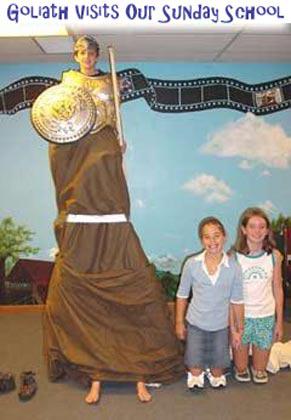
The Rotation Model's Drama Workshop lesson often takes place in a specially designated and drama-conducive classroom or space through which different grades rotate each week.
The room typically has plenty of space for moving around and staging different types of re-enactments. The room also has a collection of costumes, props, and things like an easy way to quickly hang a backdrop. In today's Drama Workshop, there's also usually a tripod for recording videos and photos, and a big screen to show them on.
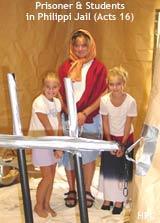 In a traditional classroom, the teacher would rarely go to the trouble of gathering all the props and staging for just one lesson, but in the Rotation Model, because the teacher would present the same basic drama lesson for several weeks in a row to a new group each week, they can take the time to set things up and not have to tear them down each week. And the teacher gets better and better each week at delivering a fun drama-infused learning experience.
In a traditional classroom, the teacher would rarely go to the trouble of gathering all the props and staging for just one lesson, but in the Rotation Model, because the teacher would present the same basic drama lesson for several weeks in a row to a new group each week, they can take the time to set things up and not have to tear them down each week. And the teacher gets better and better each week at delivering a fun drama-infused learning experience.
For example, few teachers would take the time to turn their classroom into "Paul's Prison" for just one class period. But because there is a designated space and different groups coming each week, the teacher can justify the effort to make Paul's Jail --or any other special staging or prop needed to tell a story.
All that being said, all types of teachers and models can and do glean from the Rotation Model's Drama Workshop resources.
Updated in 2023
The Drama Workshop ~ An Introduction and How-to
by Amy Crane
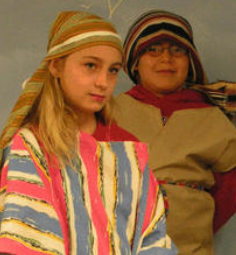 I originally wrote a version of this manual for the Palma Ceia Presbyterian Church in Tampa, Florida where I first taught in both Drama and Puppet Workshops in the Rotation Model. You can see many of my lessons and ideas in the Bible Story Lesson Forums, and I have been helping the Rotation.org Writing Team write its Drama Workshops as well.
I originally wrote a version of this manual for the Palma Ceia Presbyterian Church in Tampa, Florida where I first taught in both Drama and Puppet Workshops in the Rotation Model. You can see many of my lessons and ideas in the Bible Story Lesson Forums, and I have been helping the Rotation.org Writing Team write its Drama Workshops as well.
Since I originally wrote this manual, the concept of what you can do in the Drama Workshop has greatly and creatively expanded. There is perhaps no greater resource for all these new and exciting ideas (with full lesson plans) than the Rotation.org Writing Team Lesson Sets. ![]()
These days in the Drama Workshop, it's rare to see kids in Bible costumes reading from scripts. Instead, teachers are using scriptless and "less-script" techniques. They're combining "acting out" with narrating and improv, interacting with music-videos, "movement" and motion, recording songs, and doing shadow plays. Our Drama Workshop gurus have even experimented with moving to a song or scripture in blacklight, and they've developed small-scale "tabletop" drama approaches in our the LEGO and Storytable Workshops.
The following manual shares some general concepts and techniques and setup ideas I and other Drama Workshop aficionados have developed. To see how they work in an actual lesson plan, look up your favorite Bible story in our Lesson Forums and select "Drama Workshop."
If you're a Supporting Member, you have a treasure-trove of super-creative drama-infused lesson plans at your fingertips. Go the Writing Team's forum and pick a couple of Bible stories to see their drama lessons.
What is the goal of the Drama Workshop?
The goal of the Drama Workshop is to get kids out of their seats in playful ways to learn, share, and understand a Bible story.
Drama in all its forms makes learning fun, interactive, and memorable. It invites students to express the story and its meaning with their voices, bodies, movements, and dialog.
It helps students explore the characters, motivations, and real life dilemmas in a story and connect it to their own story and experience today.
Acting together helps build relationships, creates laughter, and breaks down walls. And it often produces a recording that the teacher can play back for reinforcement and review of key teaching points.
But what about "scripts"?
That's what many people assume the Drama Workshop is full of, and indeed, you will find "scripts" here at Rotation.org. But especially in the Writing Team's lesson sets, we've been trying to get away from "stand in a costume and read" techniques, and using more creative approaches that all kids can participate in, even those who are self-conscious or who don't read well (or at all). Indeed, we've moved toward a creative play model rather than a "put on a play" model, though that too has its time and place.
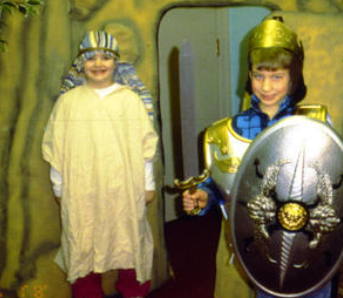
The goal isn't to repeat word-for-word what's in a Bible story, but to take what we have read and turn it into a drama the EXPLORES the MEANING of the story as it is retold. Like all good workshop lessons, good life application is not an option, it's a feature!
The Drama Workshop Teacher
Most lessons that use dramatic techniques require a teacher who is good at guiding rather than prescribing, someone comfortable with creative chaos and changes on the fly. In short, someone who is playful and good at herding kids.
The Drama Workshop teacher also needs to be able to recognize "teachable moments" that suddenly pop-up when kids are interacting with each other. This is another reason why we often suggest making a video recording of the drama activities -- so that you can keep it moving and add teaching content during the always popular "showing of the video."
Kids love to see themselves onscreen of course, and the replay is usually accompanied by lots of smiles and laughter -- which are excellent memory enhancers for your lesson!
Extra Teaching Help is always appreciated in the Drama Workshop. A parent to help with one group or key actor, and another to help with the set and video recording. Playful teens and those with drama experience usually get a big kick out of helping in the Drama Workshop -- and the kids enjoy following the teen's acting lead.
The Bible story you are teaching often helps decide WHICH dramatic teaching technique you want to use.
While you can certainly act out the scene at The Cross and Tomb using traditional props and costumes, it can also be effectively and perhaps more EASILY acted out behind a "Shadow Screen" or using Blacklight Theater techniques -- so that the kids don't have to remember lines. Instead, lines can be read by narrators, and the kids "on the stage" can focus on moving and creating the shape or "tableaux" of the event. The lines can come straight from scripture -- or be "updated" or "condensed" by the students as a preparatory activity (and great memory enhancer).
Other stories like Jesus delivering the Beatitudes can have more "literal" drama activity -- like a kid dressed as Jesus sitting on a hill and talking to his disciples (fellows students). But the highly descriptive nature of the passage opens up to each Beatitude to being ACTED OUT or posed.
You could "literally" act out the Parable of the Prodigal Son in biblical costumes, OR you could update it to modern characters. Who is the "big brother" in the story now? And what modern words would you use to describe what the Prodigal did to engage in "dissolute living"?
You could literally dramatize the Exodus and march to the Promised Land, or you could update it to a series of photos and poses showing what's holding back "kids today" in slavery and keeping them from following God?
You could literally have kids dressed in shepherd and angel costumes for a mini-Advent drama, or have them reposition it using a "flat lay" technique that is so much more fun and memorable (and watchable). The Writing Team used that technique for its Angels and Shepherds lesson set.
To depict the story of Ruth, you could roll out the Bible costumes and props again, or you could set up a "Ruth's Instagram" photo station at which students depicted certain key scenes (including poses and facial expressions) to "post" to Ruth's Instagram Page! (This idea comes from our Writing Team's Ruth Drama lesson.)
Or take the Feeding of the 5000: Instead of stopping at re-enacting the story, you could "update" the story by having the kids come up with the "fish" Jesus wants to feed us with: Baskets of justice, baskets of forgiveness, baskets of honesty, baskets of tolerance.
The Drama Technique you choose is often dictated by who you are teaching.
Have a bunch of shy students? Try shadow drama or blacklight drama.
Have a bunch of non-readers? Have them act out something that they helped you prepare being narrated to them.
Have a great group of self-starters? Break them into small groups and give them different tasks: 1-Retell the Bible story, 2-Retell it in modern setting, 3-Retell it without using words.
Preparing Your Space/Props
Drama is play. So after they've prepared what they're going to do, you want to make sure they have the fun staging and props to help them play well!
You don't need elaborate staging. Some simple costumes (scarves and lengths of fabric are fine), a few props, and a fun background are all you need for most Bible stories. Add a few "spotlights" (clamp lamps) and turn down the overhead classroom lighting --and you have a "stage."
As a fan of the Workshop Rotation Model, I firmly believe that the more special and unique we make our learning environment, the more your students will feel that something special is taking place. The "stuff" of a drama helps them "get in the mood" and get playful. Have plenty of it to choose from. Even if you are using space that is shared with other groups, you can put together a couple of buckets of costumes and props, and hang a fun backdrop to get up and running quickly, and be able to take it down quickly.
Consider creating a special seating area where the class gathers to hear the story and plan the day's drama. This allows the children to escape the everyday world when they enter the room. The group could be like Moses and the Israelites, wandering in the desert and gathering around a fire in front of a tent to hear stories. Maybe you are gathering in a synagogue sometime after the death and resurrection of Jesus to hear stories from both the Old and New Testaments. Maybe you are Christians gathered in the catacombs to hear stories of the faith. Try decorating the doorway like a time-machine and have the students put on Bible-time costumes when they enter the room (of course, you are already wearing your costume) and everyone is ready to explore a different time and place.
You will need open floor space so that there is room to move and create dramatic scenes. Use words to set the scene: "Come, let us sit here around our campfire (a few small logs) on this starry evening. See how the stars twinkle? That reminds me of the story of Abram." A few trees made from carpet tubes "planted" in five gallon plant containers with plaster and decorated with construction paper leaves or palm fronds don't take up much space and can be pushed out of the way if other groups use the room.
Use the furniture that is already in the room -as long as it isn't "clogging" your floor space. Your set could be a simple tent or cave defined by a blanket over some chairs or a table. Chairs can be arranged in a circle for a sheep pen or a boat.
If you have a space where you can leave your set up during the week, try building a more elaborate set. Use PVC piping to create a frame for a tent and drape fabric over it. To create a synagogue, have the students sit on benches facing a shelf holding your Ark (a box, cupboard or niche where the Torah is kept); use a higher shelf with brackets to attach a triangular shaped piece of wood and hang fabric as a curtain to enclose the Torah shelf. If you are meeting in a church basement or other room with annoying support columns, turn them into scenery! Cover them with papier-mâche and paint the room to look like caves or catacombs. Cardboard sheets painted to look like brick walls and homes are great to have in your drama stockpile.
If you share space, make a tent or stable that folds up against the wall when not in use. Tack a large sheet of paper to the wall or hang a piece of fabric with a curtain rod. The other edge is supported by two poles in buckets of plaster. Pull the poles out for a lean-to type tent and push the poles against the wall when you don't need the tent.
Many stories have boats (for example: Noah, Jonah, Jesus calls the disciples, Jesus walking on water, Jesus calms the storm). If you have space, have a handy member of your congregation build one out of wood. Or use an appliance box for a boat that can be folded or discarded when you are done.
Flattened appliance boxes can be easily stored and brought out when you need them. A refrigerator box can be a backdrop or a building. A stove or washer box can be a boat or can be turned on its side to be a cave. Behind a piano is a great hiding place for a folded box.
Classroom Equipment for the Drama Workshop
You'll need a flipchart or whiteboard to break down the stories, make "cue cards," and provide the occasional quick backdrop. Butcher paper on the walls works great too.
Having a video camera on a tripod is a fantastic addition to any Drama Workshop. Kids love to see "how they look," and the shout, "recording! action!" often is just what everyone needs to pull it together and focus.
These days, having a tripod to hold a cellphone to record the class is a great idea. Just remember to have a cord that connects the phone to a TV for playback as well as your charging cord.
It's fun to have a little bit of special lighting on your stage area. Clamp lights work great. Lighting can also help with special effects. And you can use them to create shadow theater (backlit screens with the actors behind the screen).
Costumes
Costumes need not be elaborate. A simple long FELT shawl or cloth tunic with slit for their head and a belt around the waist can help take a child out of the everyday and allow him or her to imagine themselves in Bible Times. Gather a few "modern" articles of clothing too -- like an old printed "church dress" and a man's jacket and tie (oversized makes it more fun). Don't forget to put hats and sunglasses in your costume box! ![]()
A good source for do-it yourself costumes and props (many of which the children can make themselves if your class time permits) is Bible Times Crafts for Kids: Experience Ancient Life- Styles and Customs with Kids from Preschool to Sixth Grade (Gospel Light, 1993).
For simple headgear to suggest a costume, look for the Paper Hat Tricks books. Several 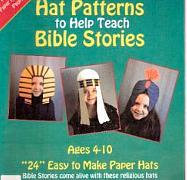 books have patterns for making "hats" out of paper specifically for Bible stories (including some great helmets for soldiers and guards).
books have patterns for making "hats" out of paper specifically for Bible stories (including some great helmets for soldiers and guards).
Look for headbands with animal ears at discount and party stores.
Check costume and party stores around Halloween and Christmas (especially during the after- holiday sales). You might find inexpensive angel wings, helmets and shields, shepherds' crooks, wigs and beards and other useful costume items.
If you need something special, especially for an adult guest storyteller, costume rental shops carry all sorts of elaborate costumes for reasonable prices.
Props
The performances are meant to be done with minimal equipment. However, if you have storage space you may want to collect some things to have on hand for when the need arises.
The following list is some "Good Stuff" to have on hand in your "magic" closet (you never know when something might come in handy!):
- musical instruments and noisemakers (including bells, whistles, kazoos, party noisemakers, harps, toy drums and xylophones
- sound effect junk (cookie tins, sticks, plastic jars or boxes with sand or rocks inside, pieces of PVC pipe, sandpaper and pieces of wood, aluminum pie plates, large pieces of posterboard, . . .)
- baskets
- bead necklaces
- logs for a campfire (no matches!)
- brown paper grocery bags and newspaper (Stuff the newspaper in the bags for a lumpy sort of rock and staple them shut. Use paint to cover the advertisements if you want something that looks nicer and is more permanent.)
- large building blocks or small boxes (which can be painted to cover up the writing)
- walking sticks
- a doll for stories with babies (or two dolls -- one "people-sized" for drama and one "puppet- sized" for puppetry)
- tinsel garland for angel halos
- a baton or decorated stick for a king's scepter
- inexpensive crowns for stories with kings and queen
- small treasure boxes and brass bowls or vases (especially for the three magi in the Christmas story)
- swords (can be found at costume and party stores, especially around Halloween, or cover cardboard with foil)
- play money or doubloons
- a fishing net
- cups and plates for stories with meals
Also keep construction paper, cardboard, markers, tape, glue, staplers, and scissors handy for when inspiration strikes.
If you have open or easily accessible shelves and if time permits, you may let the children "shop for ideas" to personalize their drama.
Helpful Hints for (Almost) Effortless Performances
* If you are excited about the project, the students will catch your enthusiasm. Keep the activity fun.
* Use plenty of positive reinforcement. Teach children to be comfortable with their mistakes and doing something funny (even if they didn't intend it to be that way).
* If necessary, choose characters by drawing names or some other impartial method. Don't let the children argue. Be sure to assign parts that require reading to those who can read well enough so as not to feel embarrassed.
* If a girl wants to take a male part, or vice-versa, no problem. For minor parts, you can change the character a bit - a traveler can be a woman instead of a man. (Remember that in Shakespeare's time, all the characters were played by men.)
* If the story has a crowd scene, everyone can participate. Otherwise, those without parts will be a very important part - the audience. Make sure those children have first chance at parts for the second run-through.
* Do not force anyone to perform. Have reluctant students work as the "stage crew" or help narrate or do sound effects and lighting. It is also good to have an audience to react to the performance, even if it is only one person. Do encourage reluctant participants to take part in the group warm-up activities.
* Do warm-up exercises with the entire class to get them in the mood and help them think through how to convey certain emotions and reactions in the story.
* Encourage other students to suggest possible dialog and reactions when someone is at a loss for words.
* Be careful about correcting students when they mis-speak, and encourage all your actors to "go with the flow" when someone makes a mistake, rather than show disdain.
* When working with older students, allow them to have more leadership and direction. Allow one of the students (or a team) to do the narration and to ask the prompting questions. (You may want to select a leader a week in advance so she or he can study the story and prepare.)
* Add sound effects: children can use their voices and bodies, noisemakers, musical instruments, and junk.
* If a child is mishandling puppets or props, give him or her one warning, then have him sit in the audience. Explain that it is important to keep our equipment in good shape so that others can use it for a number of years.
* When videotaping, unless the cameraman is experienced, it is best to have a stationary camera and have the children orient their performance toward the camera. Include time to play back the video so the students can see the results.
Remind Students of "How We Roll" in the Drama Workshop
- Everyone will eventually flub up. Learn to laugh at yourself and not laugh at someone who is embarrassed.
- Don't expect perfection from each other. Show the love! (And having to do something "over again" is a great way to really remember something!)
- Be an example to others about how to show emotion and attitude with your face, voice, and body language (not everyone learns these things or can do them as well).
- Everyone gets a part to play in front of or behind the camera, even if it's just being the "sound effects" person or audience "clapper."
I hope you've enjoyed reading my "manual." And don't miss the many other great ideas and techniques in these posts from our Rotation.org sharing community -- I can't wait to try some myself!


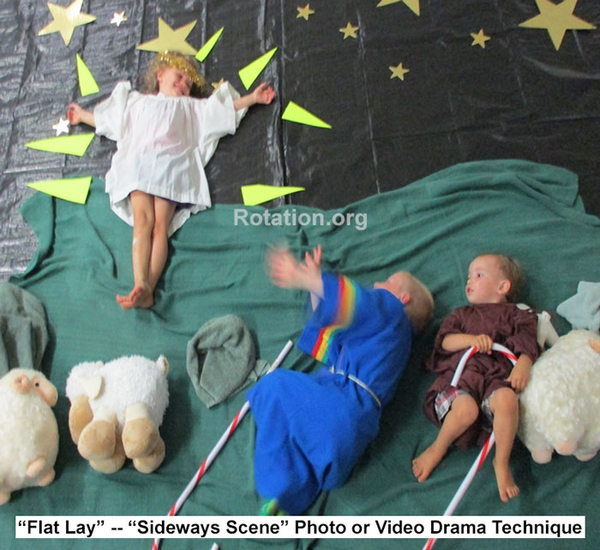
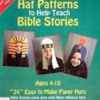




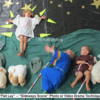
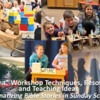
 An object lesson is a lesson that illustrates (dramatizes) a point of a story using objects (props) to focus student attention and provide a memory hook for meaning.
An object lesson is a lesson that illustrates (dramatizes) a point of a story using objects (props) to focus student attention and provide a memory hook for meaning. Change the WAY you present the drama.
Change the WAY you present the drama.